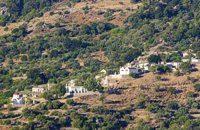
It is a small village with few residents, loacated 4 km to the west of the village Christos at an altitude of 600 m. The residents of Metaxohori (GR: Μεταξοχώρι, or Parsás - GR: Παρσάς) have immigrated to the plains of Ierapetra, in Stomio, Ammoudares and Xerokampos and work in the glasshouses. The village has been renamed in 1955 from Parsas to Metaxohori to honor the Ecumenical Patriarch Meletios Metaxakis who was born here. The Metaxohori settlement dates from the 17th century, as follows from the dating of the old churches. In the older times, Parsas, as its name was, was built at 2 km below its present position, at the site Myrtaras. Until 1929, it belonged to the Municipality of Mournies in the Province of Viannos. Since then it has been an autonomous Community, in the 90s it belonged to the Municipality of Nea Malla and today it is a Local Department of the Municipality of Ierapetra. In 1630 it had 138 residents, in 1940 it had 281, and in 2001 55 residents were registered in the census. The permanent residents however are no more than 7. Metaxohori has good infrastructures, an asphalt road, a renovated school, a memorial for the fallen fighters, beautiful old and new churches and the bust of the Patriarch Meletios Metaxakis. It is connected by a dirt road to the Symi villages Riza – Mournies. The modern history of Metaxohori is rich in important persons and facts from the period of the Turkish rule and the German Occupation. The most prominent figures were Captain Diakomanolis, during the Turkish rule, and Giorgos Metaxakis, a lawyer who worked in the Prefecture and spoke 7 languages. In 1943, 7 residents of Parsas were arrested and executed at Sfakoura of Riza. Metaxohori or Parsas, with the ruined Cretan style houses, the half-wrecked cemetery church, the wonderful natural landscapes, the view to the mountaintops, has an unbelievable tranquility, which is only disturbed by the voices of animals and birds, and a nice healthy climate. There are also amazing mountaineering routes for the nature lovers and the cave at “Kleisidi” where there are old findings, utensils and skeletons of people who took refuge there during the Turkish rule. In the north of Metaxohori, at a great altitude, there is the cave of “Neraidogoula”, which presents an inexplicable phenomenon. Sometimes in August unbelievable quantities of water flow out of the depths of the cave, flood the “Psoriaris” river and cause catastrophes. Perhaps this is why it took the name “Neraidogoula”, that is the source of the Fairy. However, in Metaxohori, the village is dominated by the figure of the Ecumenical Patriarch Meletios Metaxakis, 1871-1935. His contribution in the posts he served into was huge and his bust adorns the central square of Ierapetra. Metaxohori today waits to be repopulated, to be revived, since it has a wonderful climate and its air is scented by the verdurous mountain slopes of Dikti. Its few residents experience the tranquility and the solitude waiting for the emigrants, the mountaineers, the nature lovers to come and admire the village of the Patriarch Meletios Metaxakis.